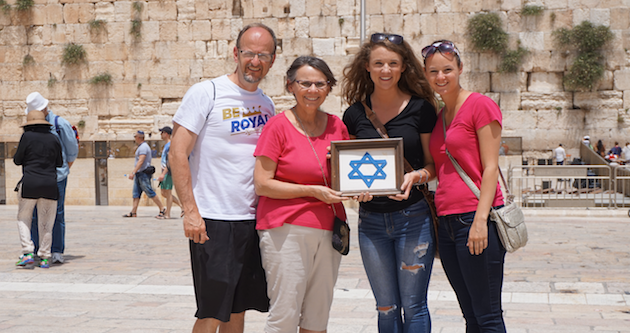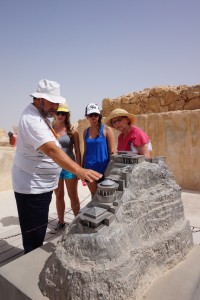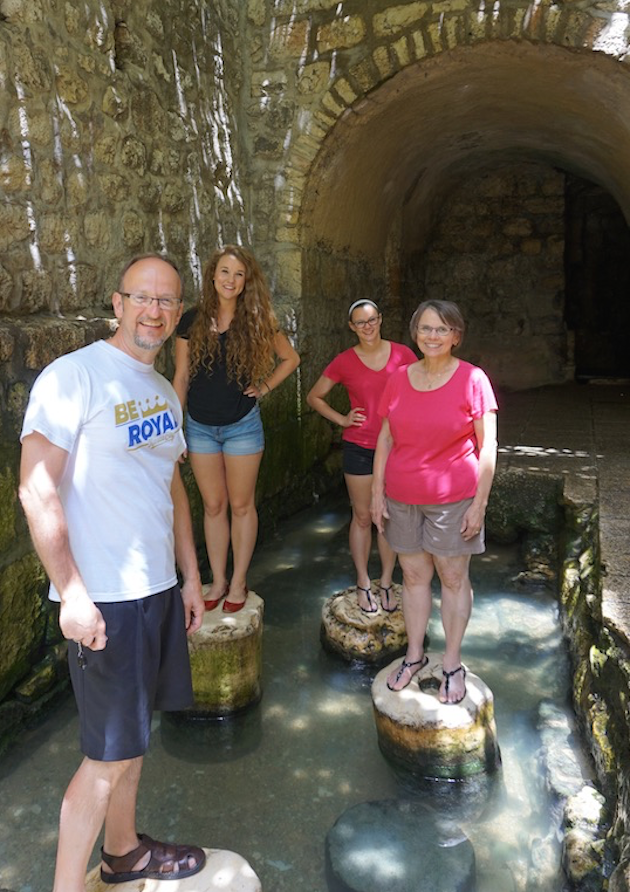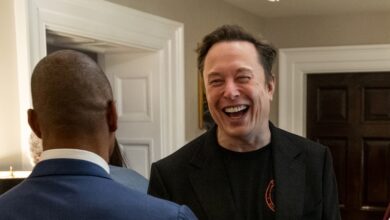
Why a journey to Israel is right for your family!
There was an air of excitement in the crowd as we scurried in to find a place to stand. Anita and I, along with our daughters, Hannah and Emma, boarded the cable car for the fast, three-minute zip to the top of Masada, Herod’s palatial mountain fortress in Israel. Along for the thrill ride were tourists from around the world, including thirty American Jewish students. Visitors from Russia, France, China and Brazil snapped pictures out of the open windows of the gondola as the landscape below seemed to rush into the distance.
Suddenly, starting with one voice, a song erupted among the American students. Anita and I smiled broadly, immediately recognizing the tune and, with people from around the world, joined in the singing:
Ain’t no mountain high enough
Ain’t no valley low enough
Ain’t no river wide enough
To keep me from getting to you.
It wasn’t an old Jewish spiritual or “zemirot”, but the classic song by Diana Ross and the Supremes! The singing continued, until no one remembered the verses and it trailed off into applause and laughter as we reached the summit, 1,300 feet above the valley below.
Part 2: Our Family Trip. Welcome to Israel!
Part 3: Our Family Trip to Israel. In the Footsteps of jesus
Standing on Masada, you can’t ignore the weight that history has placed on this one tiny corner of the world–Israel. Built by King Herod in the year 30 B.C., the fort was an architectural wonder of its day with a grand palace, army garrisons, a synagogue, warehouses filled with grain and food, and lavish swimming pools and steam baths.

For me, it was an emotional moment to stand on the ancient precipice. Below, you see where the Roman army camped after having chased a group of zealous Jewish soldiers and their families who had made Masada their last stand for freedom after Rome destroyed Jerusalem in 70 A.D. The Romans spent two years besieging Masada, finally building a ramp from the valley floor to the walls of the fortress high above.
The Roman army made it to the top and broke through, yet what they found astonished them. Instead of the Jews allowing their wives and children to raped, enslaved or tortured to death, they took the lives of their own families, then drew lots for who would be the last man to kill himself as the Romans breached the wall.
We know this because one Jew survived and recounted her story to the Romans. Archeologists have since discovered the lots, with a name for each Jewish soldier in the rubble. Their deeds left behind a saga of heroism, courage, and martyrdom unlike anything in the annals of history.
And here stood the Widaman family. How amazing!
Above our heads, in the dry 105-degree wind, an Israeli flag fluttered as evidence that God keeps his covenants! Almost 2,000 years after Rome obliterated Jerusalem, murdered its 700,000 residents and killed or dispersed every other Jew in the land, the Jewish people were here, in 2015, boldly claiming that God was not done with them and holding on to a tiny fraction of the land that God had promised to them in Genesis 15:18. “On that day the Lord made a covenant with Abram, saying, ‘To your offspring I give this land, from the river of Egypt to the great river, the river Euphrates…’” and in Joshua 1:4, “From the wilderness and this Lebanon as far as the great river, the river Euphrates, all the land of the Hittites to the Great Sea toward the going down of the sun shall be your territory.”
So, what land did God actually say belongs to Israel? All of the land modern Israel currently possesses, plus all of Samaria and Judea (what the media refers to as the West Bank), plus a slice of Egypt and Syria, plus all of Jordan, plus some of Saudi Arabia and Iraq!
Today, Israel doesn’t ask to keep all of what God gave them. It is content with just a sliver, a fraction of what God promised. It is a tiny island of eight million people in a vast sea of 400 million Muslim Arabs. Israelis just want to exist.
Should we be so amazed that God keeps His promises?
Israel’s flag boldly declares this reborn Jewish nation, while the Roman Empire is gone and relegated to the dusty pages of middle-school history books.
Should we be so amazed that God keeps His promises?
Two thousand years later there is a hunger among Christians to reconnect with Israel and yet so many still lack knowledge about the birthplace of our own faith. Our tour guide, Moshe, asked it best, “Why does Israel remain a mystery for so many? Most people have at least a working knowledge of Britain, France or Australia, though they have never set foot in those countries.”

Why are people surprised at what they see upon landing in Israel–the Holy Land? It is because reality conflicts with the image the media wants you to believe. A drive through Jerusalem’s central business district or along the Mediterranean coastline of Tel-Aviv reveals a scene not of destruction, bunkers or a population at arms but one similar to the Golden Mile of Chicago or Fort Lauderdale. Across the landscape, skyscrapers reach ever upward, touching the sky with metal and glass and cutting edge architectural designs.
The streets are filled with people of all faiths shopping, walking to school or going to work in sleek commuter trains. A drive down any freeway reveals signs for Ace Hardware, KFC, American Eagle and Forever21. Billboards hawk the latest technology–this IS the place where the cell phone and many other modern conveniences were invented–including the newest technology that runs your grandfather’s pacemaker or the newest heart surgery technique.

All of this just steps away from the most holy sites in the Jewish and Christian faiths. It’s surreal, and you have to experience it for yourself.
We encourage everyone to develop a greater understanding of the Holy Land. This past June our family had the opportunity to spend 12 days in Israel as the guests of the Israel Ministry of Tourism. Our goal was to cover Israel from an underreported angle–family travel.
This October and November we are going to take you along with us using two feature stories and photo spreads. October will cover the land, her people, and all the tastes, sights, and sounds that make Israel the most exciting place on Earth to visit with teenagers and young adults. We’ll walk through knee-deep water in Hezekiah’s tunnel, explore the Galilee on horseback and set sail on the Sea of

Galilee. We’ll share our insights of Caesarea, the Dead Sea, uncovered Roman cities, and the streets of the Old City of Jerusalem. You’ll see our reactions of walking on the actual streets that Jesus walked upon as we descend 50 feet below modern Jerusalem to the ruins of the Jerusalem that Jesus knew. You’ll peek inside the Garden Tomb and even read how the Dead Sea is springing back to life as prophesized in the Bible.
You’ll experience our time spent together as a family–the laughs and tears, the late-night walks through Jerusalem’s streets, the search for an American hamburger, and conversations with new Jewish, Christian and Muslim friends.

In November, we’ll show you how to plan your trip to the Holy Land a make it a reality. Included will be travel tips on when to go; how to get there; where to stay; we’ll answer questions such as “should you go alone or with a group?”; plus interviews with Kansas City pastors who are making the journey with their own congregations.
Most of all, we want to share with you, and perhaps experience through our words and photos, our love for the Holy Land. We’ll help you see why a trip to Israel should be a goal for every Christian. How it makes the Bible come to life and how it will enrich your understanding of Israel and bring you closer to God’s Word.
We don’t know why those American kids started singing that song from the 1960s. But looking back it seems appropriate. Nothing can keep us from the love of God and perhaps nothing should keep you from experiencing Israel for yourself and your family.
Check out Editor Dwight Widaman’s adventure traveling across Jordan. Click HERE to go to the story.
By Dwight and Anita Widaman. The award-winning Metro Voice was founded in 1989. They love to travel and share their experiences with readers.







